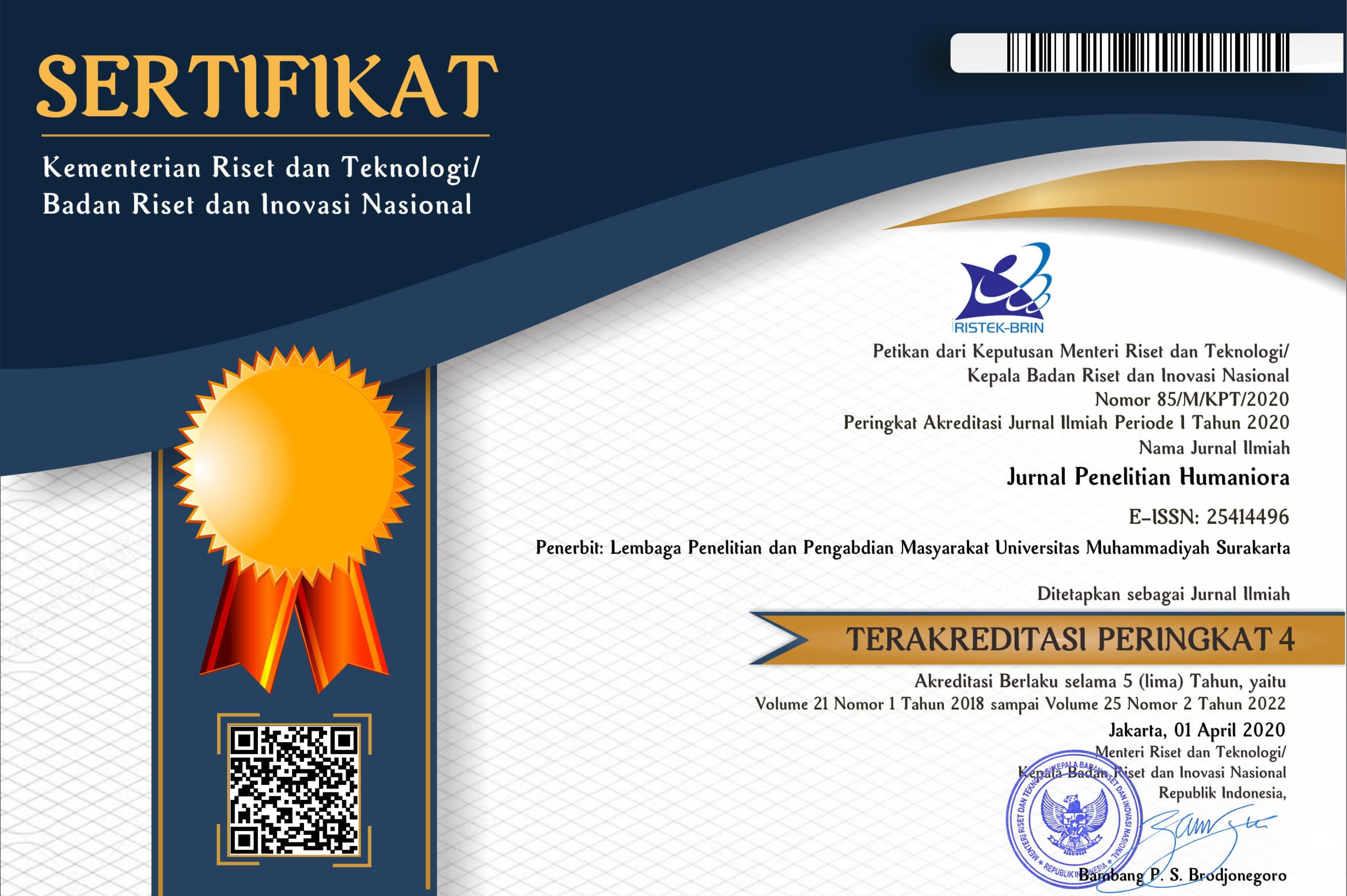AMERICAN DREAM METAPHORICAL EXPRESSIONS IN THE GREAT GATSBY
Dwi Aji Prajoko(1*)(1) Universitas Katolik Widya Mandala Surabaya
(*) Corresponding Author
Abstract
Happiness is the goal of the American dream; a means to reach happiness is wealth; in the following turn, wealth cannot be gained without optimism, opportunities, and hard work. Meanwhile, the massive use of conceptual metaphor raises the question of whether all of the domains, namely optimism, opportunities, hard work, wealth, and happiness were expressed in metaphor in the Great Gatsby whose theme is the American dream. The data collection technique was document analysis. The data were differentiated from the non-data, taxonomized, analyzed their components, and analyzed their dominance. The results show that all domains of the American dream are expressed in all types of metaphors. Structural and ontological metaphors have slight differences in terms of sum. The orientational metaphor, however, has an extreme gap compared to the first two metaphors.
Key words: American dream, metaphor, conceptual, expression
Keywords
Full Text:
PDFReferences
REFERENCES
Adams, J.T. (1931). The epic of America. Boston: Little, Brown & Company.
Almirabi, M.M. (2015). When metaphors across cultures. Journal of language teaching and research, 6 (1), 204-209.
Alvarez, A. (1993). On translating metaphor. Meta: Translators’ Journal, 38(3), 479-490.
American Association of Community Colleges. (2012). Reclaiming the American dream: A report from the 21st-century commission on the future of community colleges. Washington, DC: AACC. Retrieved from: http://www.aacc.nche.edu/21stCenturyReport
Bradley, P. (2009). Making American culture. New York: Palgrave Macmillan.
Callahan, J.F. (2006). Use of American iconography. Dalam H. Bloom (Peny.), Bloom's Guide: F Scott Fitzgerald The Great Gatsby (hal. 97-102). New York: Infobase Publishing.
Campbell, N., & Kean, A. (2005). American cultural studies: An introduction to American culture. New York: Taylor & Francis e-Library.
Fitzgerald, F.S. (1925). The Great Gatsby. Diunduh dari http://ebooks. adelaide.edu.au/
Hartmann, T. (2010). Rebooting the American dream: 11 ways to rebuild our country. New York: Berrett-Koehler Publishers.
Holy Bible. (2011). New International Version (NIV). [place unknown]: Biblica.Inc.
Knowles, M., & Moon, R. (2010). Introducing metaphor. London & New York: Routledge.
Kovecses, Z. (2010). Metaphor: A practical introduction (ed. ke-2). New York: Oxford University Press.
Lai, H.L. (2020). Playful metaphors in sex jokes and socio-cultural implications. Metaphor and Symbol 35(4), 221-235.
Lakoff, G., & Johnson, M. (2003). Metaphors we live by. London: The University of Chicago Press.
Lakoff, G., & Turner, M. (1989). More than cool reason: A field guide to poetic metaphor. London & Chicago: The Chicago University Press.
Larson, M.L. (1984). Meaning-based translation: A guide to cross-language equivalence. Lanham, New York, London: University Press of America.
Musolff, A. (2022). “World-beating” pandemic responses: Ironical, sarcastic, and satirical use of war and competition metaphors in the Context of COVID-19 Pandemic. Metaphor and Symbol, 37(2), 76-87.
Newmark, P. (1988). A textbook of translation. New York: Prentice Hall.
Puschmann, C., & Burgess, J. (2014). Metaphors of big data. International Journal of Communication 8, 1690–1709.
Reid, J.N., & Katz, A.N. (2018). Vector space applications in metaphor comprehension. Metaphor and Symbol 33(4), 280-294.
Safarnejad, F., Ho-Abdullah, I., & Awal, N.M. (2013). Rendering happiness metaphors: A cognitive analysis from Persian into English. Journal of Language Studies 13(2), 193-2005.
Santosa, R. (2012). Metode kualitatif kebahasaan (Draf buku). Surakarta: Universitas Sebelas Maret.
Smith, K.G. (2000). Bible translation and relevance theory: The translation of Titus. [unpublished disertation], The University of Stellenbosch.
Snell-Hornby, M. (1988). Translation studies: An integrated approach. Amsterdam: John Benjamins.
Spears, R.A. (2007). American idioms dictionary. New York: McGraw Hill.
Spradley, J. P. (1980). Participant observation. New York: Holt, Rinehart, and Winston.
Spradley, J. P. (2007). Metode etnografi (2nd. ed.). (M.Z. Elizabeth, Trans.). Yogyakarta: Tiara Wacana. (Karya asli diterbitkan 1979).
The Pew Charitable Trusts. (2012). Pursuing the American dream: Economic mobility across generations. Washington & Philadelphia: The Pew Charitable Trusts.
Toury, G. (1995). Descriptive translation studies and beyond. Amsterdam/ Philadelphia: John Benjamin.
Van den Broeck, R. (1981). The limits of translatability exemplified by metaphor translation. Poetics Today, 2(4), 73-87.
Yu, N., Wang, T., & He, Y. (2016) Spatial subsystem of moral metaphors: A cognitive semantic study. Metaphor and Symbol 31(4), 195-211.
Article Metrics
Abstract view(s): 1136 time(s)PDF: 1003 time(s)
Refbacks
- There are currently no refbacks.











